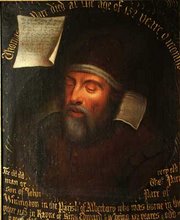Monday, January 28, 2008
Londonbesök Westminster
Den 7-9 december 2007 besökte jag tillsamman med min far Nils och bröderna Erik och Niklas London över helgen. GIvetvis hedrade vi vår anfaders grav i Westminster Abbey och the Poets corner.
Sunday, October 01, 2006
The potter, another famous Thomas Parr

Despite introduction of the commercially successful flatback (modeled and decorated only in the front with flat backs designed for placement on mantelpieces), one mid-nineteenth century potter, Thomas Parr, maintained a high standard of artistic integrity and produced figures that were finely modeled and decorated in the round. Parr pulled figure making from the quicksand of commercialism, and his work fit into the broader spectrum of the arts, returning truth to medium and ennobling craftsmanship. But Parr was singular and, although the figure-making industry remained strong through all of Victoria's long reign (1837-1901), quality declined substantially by the 1880's. Ubiquitous Spaniels, portraits, and nearly all types of figures took on a "formula" look, and once-vibrant colors were replaced by simple white and gilt decoration. By the time of World War I, figure making had become passé.
The memory of Parr kept alive by almenacs
The seventeenth-century almanac writer Jonathan Dove three times mentions Thomas Parr's death in his 'Memorable Accidents; or A Chronologicall description of many things worthy of memory'. Parr's death is in esteemed company with such events as
-Constantine procuring peace for Christians,
-the Turks taking Jerusalem from the Sarazens, and
-Cambridge University being founded.
See Jonathan Dove, Speculum anni partu Virginis MDCXLIII, or, An Almanack for the year of our Lord God 1643 and subsequent editions in 1647 and 1649.
-Constantine procuring peace for Christians,
-the Turks taking Jerusalem from the Sarazens, and
-Cambridge University being founded.
See Jonathan Dove, Speculum anni partu Virginis MDCXLIII, or, An Almanack for the year of our Lord God 1643 and subsequent editions in 1647 and 1649.
Arundels stormy relationship with king Charles
To bring Parr to London is consonant with Arundel's need to win points with Charles. In contrast to what had been Arundel's warm friendship with James, the Earl's relationship to Charles was stormy; it included his being imprisoned in the Tower and being forced to give up the hereditary dukedom of Norfolk.
Arundel; collector of antiquities

The act of having Parr carted to London is consonant with the Earl's reputation as a zealous collector of antiquities. While his travels on the Continent usually netted him sumptuous portraits by Italian masters – he owned in all more than eight hundred paintings by 1642 – or statuary relics from his archaeological digs of ancient Rome. In Parr he reels in an aged human being, a relic of the pastoral life.
The fascination with collecting antiquarian specimens and the aristocratic quest for rarities, in the early seventeenth century did not bespeak a genuine interest in science. It was only a superficial and amateurish commitment to the Baconian ideal of experimental science, or rather the very antithesis of it. Instead, 'it encouraged the mentality of the fair-ground peep-show'. Arundel is a greedy urban colonist, Parr a spectacle of biblical age, an aristocrat's Elephant Man.
The discovery of the 2nd Earl of Arundel and Surrey

Parr became a celebrity, albeit briefly in his own lifetime. In 1635 his fame reached the ears of Thomas Howard, 2nd Earl of Arundel and Surrey who was visiting one of his Shropshire estates. The Earl heard all about the incredible 'old, very old man' known as "Old Parr", then said to be l52 years old and working as a farmer near his country seat.
Parr was visited by the Earl at his small hamlet near Shrewsbury in Shropshire. When the Earl encountered Parr he was decided to bring him to London and exhibit the marvel at court and persuaded Parr to visit the King in London. Parr left Shropshire never to return.
The South Transept

The South Transept is lit by a large rose window and one of the best known parts of Westminster Abbey, Poets' Corner can be found here. It was not originally designated as the burial place of writers, playwrights and poets.
The first poet to be buried here, Geoffrey Chaucer, was laid to rest in Westminster Abbey because he had been Clerk of Works to the palace of Westminster, not because he had written the Canterbury Tales. Over 150 years later, during the flowering of English literature in the sixteenth century, a more magnificent tomb was erected to Chaucer and in 1599 Edmund Spenser was laid to rest nearby. These two tombs began a tradition which developed over succeeding centuries. Shakespeare, buried at Stratford-upon-Avon in 1616, had to wait until 1740 before a monument appeared in Poets' Corner.
Poets
-Lord Byron
-John Dryden
-Tennyson
-Robert Browning
-John Masefield.
Writers:
-William Camden
-Dr. Samuel Johnson
-Charles Dickens
-Richard Brinsley Sheridan
-Rudyard Kipling
-Thomas Hardy
Not all those buried in the South Transept are poets or writers. Several of Westminster's former Deans and Canons lie here. Also buried here is Thomas Parr, who was said to have died at the age of 152 in 1635 after having seen ten sovereigns on the throne during his long life.
Subscribe to:
Posts (Atom)
